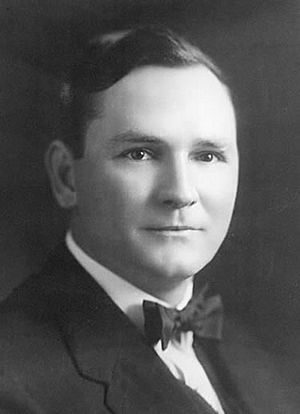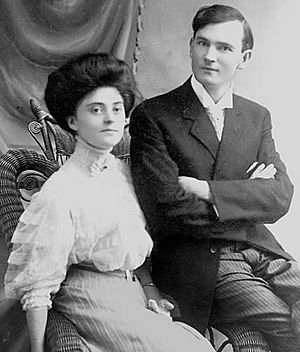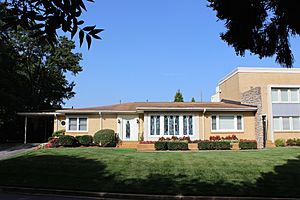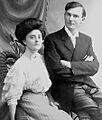Bob Jones Sr. facts for kids
Quick facts for kids
Bob Jones Sr.
|
|
|---|---|
 |
|
| Born |
Robert Davis Reynolds Jones
October 30, 1883 |
| Died | January 16, 1968 (aged 84) |
| Resting place | Bob Jones University |
| Nationality | American |
| Occupation | Evangelist University administrator |
| Title | President of Bob Jones University |
| Term | 1927-1947 |
| Successor | Bob Jones, Jr. |
| Spouse(s) | Bernice Sheffield (1905-1906; died after 10 months), Mary Gaston Stollenwerck Jones |
| Children | Bob Jones, Jr. |
| Parent(s) | William Alexander Jones Georgia Ann Creel Jones |
Robert Reynolds Jones Sr. (October 30, 1883 – January 16, 1968) was an American evangelist. He was also a pioneer in religious broadcasting. He is best known as the founder and first president of Bob Jones University.
Contents
Early Life and Talents
Bob Jones was born in 1883 in Dale County, Alabama. He was the eleventh of twelve children. His parents were William Alexander and Georgia Creel Jones. His father, a veteran, worked a small farm. Bob often helped by selling vegetables door-to-door. He later said this helped him build character.
Bob's early schooling was not like today's. But he was very smart and good at speaking. His father made him memorize parts of the Bible and other writings. Bob was shy, but he often performed for guests. He later remembered how hard it was to "say the speech."
However, he quickly got over his stage fright. By age twelve, he gave a strong speech. He stood on a box in front of a store in Dothan. A Methodist missionary, Dr. Charles Jefferson Hammitt, noticed his talent. Bob lived with the Hammitts and helped them. He graduated from Mallalieu Seminary in 1900.
The next year, he went to Southern College. He paid for his studies by preaching. He left college in 1904 without a degree. He was already a well-known evangelist. He also needed to help his two widowed sisters.
By the time Bob was 17, both his parents had passed away. In 1905, he married Bernice Sheffield. She became sick and died within ten months. On June 17, 1908, he married Mary Gaston Stollenwerck. They met when she sang in a choir at one of his meetings. Their only child, Bob Jones Jr., was born in 1911. Mary Gaston Jones lived to be 100 years old.
Becoming a Preacher
Bob Jones's family was very religious. His mother was a Primitive Baptist, and his father was a Methodist. Bob became a Christian at age 11. He was baptized by immersion, which was a bit different for a Methodist.
At age 12, Bob became the Sunday School superintendent. He held his first revival meeting at his home church. Sixty people became Christians in one week. At 13, he built a simple shelter called a "brush arbor." He started his own church with 54 members.
By age 15, Bob was a licensed preacher for the Alabama Methodist Conference. A year later, he was in charge of five churches. He earned $25 a month. He was surprised that he didn't get "spoiled" by all the attention. People came from everywhere to hear him preach.
In the early 1900s, evangelistic meetings were very popular. Newspapers often wrote about them for weeks. Bob Jones's meetings were frequently front-page news. By the 1920s, he was one of the most famous evangelists in the United States. Only Billy Sunday was more well-known.
His campaigns had amazing results. For example, in 1917, he held a seven-week meeting in Zanesville, Ohio. The town had 22,000 people. Over 3,300 people became Christians. Many joined churches on Easter Sunday. In 1921, Muskingum College gave him an honorary doctorate degree. This was the first of many such honors.
By age 40, Jones had preached to over fifteen million people. He did this without microphones. He was known for helping tens of thousands of people become Christians. Crowds could be as large as 15,000 people. He had to speak loudly and use big gestures. A reporter once noted that he "pounded the altar so hard he broke it."
Starting a University
In the 1920s, there was a big debate in Christianity. It was called the Fundamentalist-Modernist controversy. Bob Jones was worried that colleges were becoming less religious. He saw that many students were losing their faith. In 1924, his friend William Jennings Bryan told him something important. Bryan said, "If schools and colleges do not quit teaching evolution as a fact, we are going to become a nation of atheists."
In 1925, after the famous Scopes Trial, Jones had an idea. He and his wife were driving in Florida. They were talking about the need for a Christian college. This college would offer a different path. It would be for students who wanted to keep their faith strong. Suddenly, Jones announced he would start such a school. His wife was surprised and asked if he was "crazy."
Jones immediately drove north. He started asking friends about a good location. On April 14, 1926, a charter was approved. This allowed him to start the college in Panama City, Florida. He sold land to raise money for the school. On December 1, 1926, construction began near Lynn Haven, Florida.
The college opened on September 12, 1927, with 88 students. Jones didn't want to name the school after himself. But his friends convinced him. They said people would call it by his name anyway. So, it became Bob Jones College.
Bob Jones did not take a salary from the college. For many years, he even used his own money to support it. He used savings and money from his preaching. The timing was difficult. A land boom had ended, and a hurricane hit in 1926. Then came the Great Depression. Bob Jones College almost went bankrupt.
In 1933, the school moved to Cleveland, Tennessee. Its reputation grew. After World War II, many soldiers went to college using the GI Bill. The college needed a bigger campus. In 1947, the school moved to Greenville, South Carolina. It was then renamed Bob Jones University.
By this time, his son, Bob Jones, Jr., was managing the daily operations. But Bob Jones Sr. still raised money. He preached regularly in chapel services. He inspired many students who wanted to become ministers. In the early 1960s, his health began to decline. He retired in 1964. He passed away in 1968.
Reaching People Through Radio
New technologies like radio and movies changed evangelism. Bob Jones saw these as new ways to share his message. In the early 1920s, he was one of the first religious leaders to broadcast on radio. His meetings in Pittsburgh in 1925 were among the first religious broadcasts.
In 1927, Jones started a daily and weekly radio program. It was heard from New York to Alabama. He kept his radio ministry going for 35 years. He stopped only when his health failed in 1962. In 1944, Jones helped start National Religious Broadcasters. He also served as a director.
Jones understood that speaking on radio was different from preaching to large crowds. His radio sermons were more personal and friendly. About three thousand of his ten thousand radio messages still exist. They are still played on the radio today.
Religious Views
Bob Jones was a Protestant Christian. When he founded Bob Jones College, he wanted a clear statement of faith. The Bob Jones University creed was a short summary of traditional Christian beliefs. It focused on ideas that were being questioned at the time. For example, it stated that the Bible was inspired by God. It also rejected the theory of human evolution.
Jones tried to find a middle ground between different Christian ideas. He believed that people should accept "whatever the Bible says is so." He thought this was true even if it didn't fit a specific religious system.
He believed that people needed salvation through Jesus Christ. His early sermons often spoke against social problems. These included drinking, dancing, and not respecting Sunday. He thought these could be improved by laws and by people changing their lives.
Jones also had practical views on education. He believed in Christian higher education. But he also said that faith should not just be based on human arguments. He wanted his students to make "truth simple and easy to grasp." He wanted everyone to understand the Christian message.
In the 1950s, Jones played a role in a split among Protestant Christians. This was between fundamentalism and neo-evangelicalism. Evangelist Billy Graham had attended Bob Jones College briefly. The university even gave him an honorary degree in 1948. In the 1940s, Jones and Graham seemed to have a father-son relationship.
However, in the 1950s, Graham started to move away from older fundamentalist ideas. In 1957, he worked with many different church groups for his New York Crusade. Jones believed that some people on Graham's committee did not believe in key Christian ideas. Jones felt Graham was going against a Bible teaching. Members of Graham's group said Jones was jealous. Jones wrote that he was an old man and didn't want to fight. But he would not "go back on the Lord Jesus Christ." This disagreement led to a lasting split between fundamentalist and evangelical groups.
Political Views
Bob Jones enjoyed politics and was friends with many politicians. He was asked to run for office several times. In the 1928 presidential election, Jones supported Republican Herbert Hoover. He campaigned against Democrat Al Smith. Jones had strong views about politics and society.
Writings
- Bob Jones' Sermons
- On Here and Hereafter
- "My Friends" (radio messages based on Jones's chapel sayings)
- Things I Have Learned: Chapel Talks by Bob Jones Sr. (1945)
- Is Segregation Scriptural? (1960)
Images for kids






